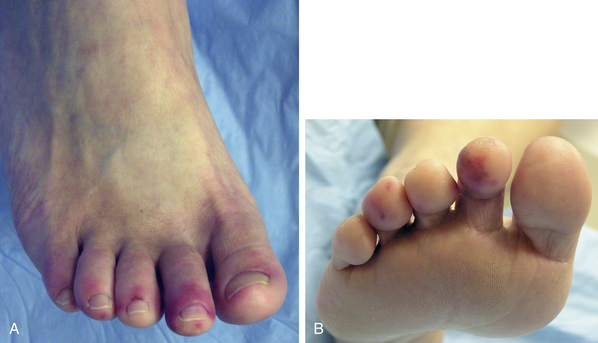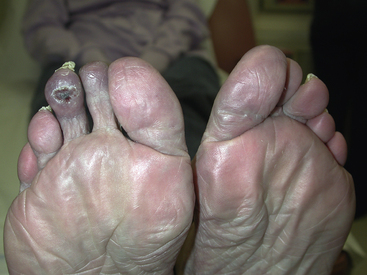Chapter 51 Pernio (Chilblains)
Pernio, commonly known as chilblains, is a cold-induced localized inflammatory condition presenting as skin lesions predominantly on unprotected acral areas. Typically there is swelling of the dorsa of the proximal phalanges of fingers and toes (Fig. 51-1). Pernio is a Latin term meaning “frostbite.” Chilblains is an Anglo-Saxon term used in older literature and means “cold sore.” The tissue and vascular damage is less severe in pernio than in frostbite, in which the skin is actually frozen. The numerous names that were used to describe this syndrome created much confusion and misunderstanding of this entity1 (Box 51-1). In the mid-1800 s, there were attempts to better classify the disease2 and in 1894, Corlett was the first to describe the clinical characteristics of pernio, which he called dermatitis hiemalis.3
Epidemiology
The first epidemiological study to explicate the prevalence of chilblains and its impact on productivity in servicewomen was carried out in 1942 by the U.S. Medical Department of the War Office.4 The study concluded that at least 50% of questionnaire participants had chilblains by age 40 during World War II (1939-1943). Although pernio is most common in young women, it has also been reported in all ages and both sexes.5–8 The number of reported cases of pernio is higher during times of wet near-freezing weather, and less common in dry freezing weather or in a bitterly cold climate.9 Pernio is most commonly encountered in the northern and western parts of the United States; isolated cases have been reported in warmer climates in times of cooler damp weather.5,6,10–12
As shown by a recently reported cross-sectional study conducted by the U.S. Army, the yearly rate of cold weather injuries declined from 38.2/100,000 in 1985 to 0.2/100,000 in 1999.13 This and other observations from clinical practice suggest that the disease is becoming less common with higher standards of home and workplace heating and greater use of appropriate clothing during the cold winter months. Also, the study confirmed previous investigations that cold weather injuries in African American men and women occurred approximately 4 and 2.2 times as often, respectively, as in their Caucasian counterparts.
Pathophysiology
The first response to cold exposure is vasoconstriction in the dermis and subcutaneous tissue. Heat loss is minimized by shutting down distal capillary beds and diminishing blood supply to the acral portions of the extremities to maintain central body temperature. Stasis and shunting of blood flow away from the superficial vessels occurs secondary to arteriolar constriction, venular relaxation, and cold-associated increased blood viscosity. The result of these changes is superficial tissue anoxia and ischemia.7,9,14–16 The arteriolar vasoconstriction described in pernio has been demonstrated in pathological and radiographic studies.6,7 Female predominance may be related to increased responsiveness of their cutaneous circulation to cold. Indeed, there is a higher frequency of vasomotor instability, cold hands and feet, and Raynaud’s phenomenon in women.8,17–19
Humidity has an important role in the pathophysiology of pernio because it enhances air conductivity, promoting heat loss from the skin.5,8 Most individuals tolerate exposure to nonfreezing damp cold, but others may experience pernio, Raynaud’s phenomenon, acrocyanosis, or cold urticaria.8,18 The clinical manifestations of cold injuries are related to duration, severity, and dampness of cold exposure as well as the individual’s underlying predisposition to cold injury and the stage at which medical attention was sought.7 The exposed skin of affected subjects remains cool longer and warms slower than that of controls, further highlighting the importance of individual susceptibility for development of pernio after cold exposure.6–8,20 The increased incidence of pernio among relatives of affected patients suggests the possibility of genetic predisposition.4 Several other conditions have been proposed to promote vulnerability to the disease (Box 51-2).
Why one patient exposed to cold develops Raynaud’s phenomenon and another pernio is unclear. Raynaud’s phenomenon and pernio frequently coexist in the same patient, so these diseases may be part of a continuum, with Raynaud’s phenomenon representing acute and readily reversible vasospasm, and pernio representing more prolonged vasospasm with more chronic changes.8,21
A number of conditions have been associated with pernio. Weston and Morelli reported the presence of cryoproteins in four of eight children presenting with pernio.11,22 Since cryoproteins and cold agglutinins may be detected transiently after viral infections, they hypothesized that exposure to cold wet weather during the brief cryoproteinemia may lead to exaggerated tissue injury manifesting as pernio. Pernio has been described both in women with large amounts of leg fat and in women with inadequate fat pads, as seen in anorexia nervosa.5–7
The possibility that pernio may be a manifestation of a pre-leukemic state, namely the chronic myelomonocytic type, has been suggested in several case reports in which skin lesions and a clinical course similar to that of pernio were observed.5,23–25 In some of these cases, leukemia was diagnosed 6 to 36 months after the pernio-like illness.
Viguier et al. reported observations over 38 months on a cohort of 33 patients with severe chilblains, defined as duration of lesions greater than 1 month.21 Two thirds of the patients had clinical and/or laboratory features supporting a diagnosis of connective tissue disorders: 12 patients had systemic lupus erythematosus (SLE) and 10 patients presented with at least one of the American College of Rheumatology revised criteria for SLE at the time of the diagnosis of pernio. In the latter group, all patients except one had positive antinuclear antibody (ANA) titers. These observations led the authors to conclude that when the lesions persist beyond the cold season, perniotic lesions may be a clue to underlying SLE. Therefore, targeted laboratory investigations to search for conditions listed in Box 51-2, as well as long-term follow-up, are recommended for patients who present with pernio.26
Histopathology
Although not routinely required to establish the diagnosis, biopsies are occasionally sought by healthcare providers unfamiliar with the disease.27 The histopathological features of perniotic lesions may vary depending upon the chronological stage of the disease and presence or absence of superimposed secondary pathology such as infection or ulceration.7,28,29
The characteristic histopathological features of pernio are usually seen in the dermis and subcutaneous tissue, but are not pathognomonic. These consist of edema of the papillodermis, vasculitis characterized by perivascular infiltration of the arterioles and venules of the dermis and subcutaneous fat by mononuclear and lymphocytic cells, thickening and edema of blood vessel walls, fat necrosis, and chronic inflammatory reaction with giant cell formation.8 Not all these changes are necessarily present, and fat necrosis and giant cell formation are frequently absent. The most consistent feature is perivascular lymphocytic or mononuclear infiltrates.28
Repeated episodes of vasospasm or prolonged vasospasm may cause tissue anoxia, thus causing the identical histopathological picture that occurs in pernio.1 The histological pattern of pernio lesions may mimic cutaneous vasculitis but typically lacks fibrinoid deposition, inflammatory cells in the vessel wall, and thrombosis, typical of true vasculitis.5–7,11,27,29–33 Blood vessels in long-standing pernio resemble those of any chronic occlusive vascular disease. The occlusion and fibrosis present are due to long-standing injury; this histopathological appearance may be seen in many other types of vascular disease.
Review of published case series and case reports support the notion that pernio may display different and loosely related histological features.33 Cribier et al. retrospectively compared the biopsies of hand lesions from 17 patients with chilblains to those of 10 patients with proven SLE and associated pernio-like hand lesions.27 The study included only acute lesions (<1 month duration) occurring during the cold period of the year. The most characteristic finding in chilblains (47% of cases) was the association of edema and reticular dermis infiltrate that showed a perieccrine reinforcement: dermal edema (70% of chilblains lesions vs. 20% of SLE lesions), superficial (papillary) and deep (reticular) infiltrate (82% vs. 80%), and deep perieccrine reinforcement (76% vs. 0%). The infiltrate was composed primarily of T cells, which were predominantly CD3+. Remarkably, 29% of the chilblain lesions in this group showed evidence of microthrombi (compared to 10% in the lupus group), usually a feature seen in vasculitis, and 6% had conspicuous vacuolation (compared to 60% in the lupus group).
In another study, Viguier et al. prospectively studied 33 patients with severe prolonged chilblains (i.e., lesions persisted >1 month) and attempted to differentiate the histopathological characteristics of lesions of “idiopathic” pernio from those of pernio-like lesions in patients with connective tissue diseases or lupus pernio.21 Skin punch biopsies were performed on 5 of 11 patients of the “idiopathic” pernio group, and these showed deep dermal, perisudoral lymphocytic infiltrate (100%), dermal edema (75%), keratinocyte necrosis (62.5%), and keratinocyte vacuolization (50%). In comparison, biopsies from 7 of the 12 patients with the diagnosis of SLE (LE chilblain), demonstrated perisudoral cellular infiltrate in only two patients (vs. 8/8 in the “idiopathic” chilblains group; P = .007). Biopsy is rarely needed to make the diagnosis of pernio, but a biopsy may be helpful in differentiating atheromatous embolization from pernio in an ischemic-looking lesion (Fig. 51-2).
< div class='tao-gold-member'>
Stay updated, free articles. Join our Telegram channel

Full access? Get Clinical Tree




